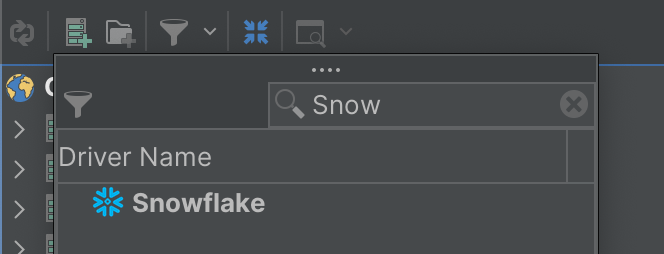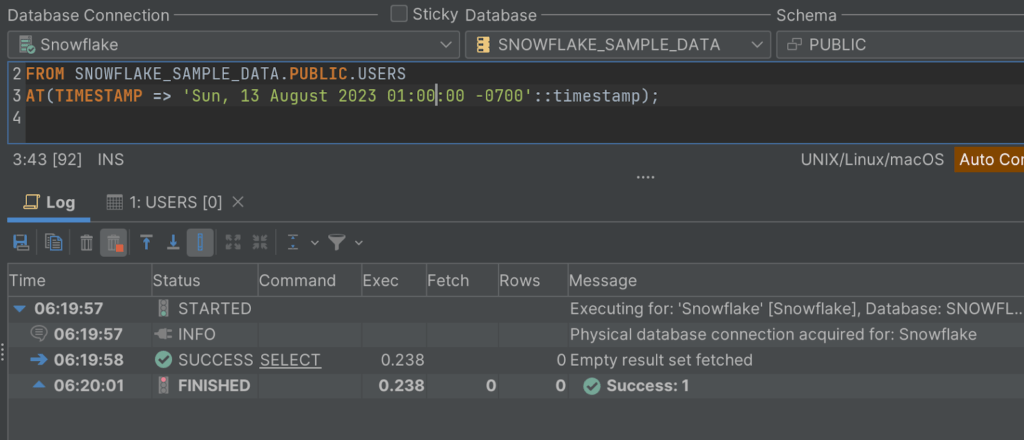intro
Learn how to leverage Snowflake's Time Travel feature in conjunction with DbVisualizer to effortlessly explore historical data, restore tables to previous states, and track changes for auditing and compliance purposes.
Introduction
Welcome to our tutorial on leveraging Snowflake's powerful Time Travel feature in combination with DbVisualizer. Snowflake's Time Travel provides an exceptional capability for data versioning, allowing you to delve into the past and query historical data effortlessly. By using Time Travel, you gain the ability to access data as it appeared at any given point in time within a specified retention period, all without the complexities of traditional backup and restore processes. This feature not only simplifies auditing and compliance requirements but also empowers you with granular control over data versions.
Throughout this tutorial, we will explore the numerous benefits and use cases of leveraging Snowflake's Time Travel. You'll discover how it facilitates data recovery, making it a valuable tool to rectify data corruption or accidental changes. Moreover, Time Travel enables historical analysis by uncovering data trends and patterns, empowering data scientists and analysts to gain deeper insights.
By leveraging Time Travel in conjunction with DbVisualizer, a versatile database management and visualization tool, you'll be able to efficiently query and explore historical data. This tutorial will guide you through the process of setting up Snowflake and DbVisualizer, configuring the connection, and demonstrating effective usage of Time Travel to enhance your data management workflows.
Get ready to unlock the full potential of Snowflake's Time Travel feature, as we equip you with the knowledge and skills to harness its power, streamline your data versioning processes, and uncover invaluable insights from your historical data. Let's dive in!
Prerequisites
To follow this tutorial, you will need the following:
Setting Up Snowflake and DbVisualizer
In this section, we'll walk you through the process of setting up Snowflake and connecting it to DbVisualizer, enabling you to seamlessly manage and analyze your data.
Creating a Snowflake Account and Setting Up a Virtual Warehouse
Configuring a New Database Connection in DbVisualizer




Then click on “Start Download” to download the required JDBC driver for Snowflake.


If the test is successful, you'll receive a confirmation message indicating that DbVisualizer can connect to Snowflake using the specified parameters.
Exploring Time Travel in Snowflake
Time Travel is a powerful feature offered by Snowflake, a cloud-based data warehousing platform, that allows you to query historical data at various points in time. This feature is particularly valuable for analytical and auditing purposes, as it enables you to track changes to your data over time without the need for complex versioning or snapshotting mechanisms.
In Snowflake, every table is associated with a period, referred to as a "time travel period." This period represents the duration for which historical data is retained in the table. Snowflake automatically maintains a history of changes made to data during this period, allowing you to retrieve data as it existed at different points in the past.
Enabling Time Travel for a Snowflake Database
Enabling Time Travel is straightforward in Snowflake and can be configured at the database level. When creating or altering a database, you can specify the time travel retention period. This period determines how far back in time you can query historical data. Time travel retention can be set in terms of hours, days, or even for an infinite retention.
For example, to create a database with a time travel retention period of 30 days, the SQL query would look like this:
1
CREATE OR REPLACE DATABASE my_database DATA_RETENTION_TIME_IN_DAYS = 30;
This means that data changes made in the past 30 days can be queried using the Time Travel feature.

Querying Historical Data Using Time Travel Syntax in DbVisualizer
DbVisualizer is a popular database management and visualization tool that supports various database systems, including Snowflake. To query historical data using Time Travel in DbVisualizer, you can follow these steps:
1
SELECT *
2
FROM your_table
3
AT(TIMESTAMP => 'Sun, 13 August 2023 01:00:00 -0700'::timestamp);
Would fetch all rows from the specified table as they existed at the given timestamp.

1
SELECT *
2
FROM SNOWFLAKE_SAMPLE_DATA.PUBLIC.USERS
3
AT(TIMESTAMP => 'Sun, 13 August 2023 01:00:00 -0700'::timestamp)
4
WHERE registration_date < '2023-08-01';
Utilizing Time Travel for Data Recovery and Auditing
Time Travel in Snowflake goes beyond its role in historical data analysis; it also serves as a powerful data recovery and auditing mechanism. Whether you're exploring the past or rectifying accidental changes, Time Travel offers a smooth path to data restoration. This section delves into how you can employ Time Travel for data recovery and auditing purposes.
Restoring a Table to a Previous Point in Time using Time Travel
Time Travel in Snowflake not only facilitates historical data analysis but also serves as a data recovery mechanism. In scenarios where you need to restore a table to a previous state, Time Travel provides a seamless solution. Here's how you can achieve this:
1
INSERT INTO new_table
2
SELECT *
3
FROM original_table
4
AT(TIMESTAMP => 'Sun, 06 August 2023 01:00:00 -0700'::timestamp);
This populates the new table with the data from the past.
Auditing Changes and Tracking Data Modifications with Time Travel
Time Travel is a valuable tool for auditing purposes, allowing you to track changes and modifications made to your data over time. By leveraging Time Travel, you can maintain an accurate record of every change without the need for complex versioning systems. This is particularly beneficial for compliance, regulatory, and internal auditing requirements.
1
CREATE TABLE audit_changes (
2
change_id INT AUTOINCREMENT PRIMARY KEY,
3
user_id STRING,
4
change_description STRING,
5
change_timestamp TIMESTAMP
6
);
1
-- Create a stream for the historical table
2
CREATE OR REPLACE STREAM historical_changes_stream ON TABLE SNOWFLAKE_SAMPLE_DATA.PUBLIC.USERS;
1
-- Create a task to populate the audit_changes table using the stream
2
CREATE OR REPLACE TASK populate_audit_changes
3
WAREHOUSE = COMPUTE_WH
4
SCHEDULE = '1 MINUTE'
5
WHEN SYSTEM$STREAM_HAS_DATA('historical_changes_stream')
6
AS
7
INSERT INTO SNOWFLAKE_SAMPLE_DATA.PUBLIC.audit_changes (user_id, change_description, change_timestamp)
8
SELECT '123', metadata$action, CURRENT_TIMESTAMP
9
FROM historical_changes_stream;
10
11
COMMIT;
1
ALTER TASK populate_audit_changes RESUME;
2
SHOW TASKS LIKE 'populate_audit_changes';
3
COMMIT;

With this configuration in place, any modifications made to the `USERS` table will be automatically captured and logged into the `AUDIT_CHANGES` audit table. This mechanism allows you to effortlessly maintain a detailed record of alterations and their respective context.

Conclusion
In this tutorial, we've delved into Snowflake's Time Travel feature, showcasing its versatility in data recovery and auditing. Time Travel isn't just about historical analysis—it's a tool that simplifies data restoration and empowers robust auditing.
We began by grasping the essence of Time Travel—its ability to query data as it appeared at various times. This streamlines auditing, compliance, and versioning without complex backups.
We navigated setting up Snowflake and DbVisualizer, fusing data warehousing capabilities with an intuitive interface.
Our journey through Time Travel involved enabling it, executing queries in DbVisualizer, and refining queries for insights.
Beyond data recovery, we harnessed Time Travel for auditing. We explored restoring tables, tracking changes through an audit_changes table, and using Snowflake's features to populate it.
As we conclude, remember the fusion of DbVisualizer and Snowflake's Time Travel. This dynamic duo enhances data management, analysis, and visualization. Embrace DbVisualizer to unearth insights and streamline data tasks. Your data adventures await—happy exploring!
Frequently Asked Questions (FAQs)
What is Snowflake's Time Travel feature, and how can I use it to query historical data?
Snowflake's Time Travel feature allows you to access historical data within a specified retention period. You can query data as it appeared at different points in time, without the need for complex backup and restore processes. To learn how to leverage this feature alongside DbVisualizer for efficient exploration and analysis of historical data, check out the tutorial on "Leveraging Snowflake's Time Travel with DbVisualizer."
How can I effectively use Snowflake's Time Travel in combination with DbVisualizer for auditing and compliance purposes?
Ar: If you're interested in tracking changes and maintaining an audit trail for your data, you can leverage Snowflake's Time Travel feature alongside DbVisualizer. By following the tutorial on "Leveraging Snowflake's Time Travel with DbVisualizer," you can learn how to set up Snowflake, configure the connection, and use Time Travel to effortlessly explore historical data, restore tables to previous states, and track changes for auditing and compliance purposes.
What are some practical use cases for Snowflake's Time Travel feature, and how does it benefit data analysis?
A: Snowflake's Time Travel is not only valuable for data versioning and recovery but also for historical analysis. By using Time Travel, you can uncover data trends, patterns, and insights from the past. The tutorial on "Leveraging Snowflake's Time Travel with DbVisualizer" demonstrates how to harness this feature to enhance data analysis workflows, making it easier to gain valuable insights from historical data.
How can I connect Snowflake with DbVisualizer to streamline data management tasks and analysis?
A: Connecting Snowflake with DbVisualizer can enhance your data management and analysis capabilities. DbVisualizer is a versatile tool that allows you to manage, query, and visualize databases in a user-friendly interface. If you're interested in learning how to set up this connection and leverage Snowflake's Time Travel feature, check out the tutorial that provides a step-by-step guide on "Leveraging Snowflake's Time Travel with DbVisualizer."
Where can I find a comprehensive guide on using Snowflake's Time Travel feature with DbVisualizer for historical data exploration and analysis?
A: If you're looking for a detailed guide on using Snowflake's Time Travel feature alongside DbVisualizer, there's a tutorial available titled "Leveraging Snowflake's Time Travel with DbVisualizer." This guide walks you through the process of setting up Snowflake, establishing a connection with DbVisualizer, and effectively using Time Travel to explore historical data, restore tables, and track changes for various purposes.


